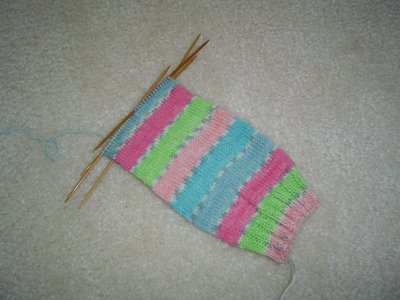My Generic Sock
 I've started another sock and it occurred to me that I had never shared my own formula for a generic sock. Most people who have knit several pairs of socks adopt certain ways of doing them so I thought I'd share mine. This is in no way a copyrighted technique so feel free to use it, adapt it, or ignore it at will. This is how I knit a sock with any yarn at any gauge.
I've started another sock and it occurred to me that I had never shared my own formula for a generic sock. Most people who have knit several pairs of socks adopt certain ways of doing them so I thought I'd share mine. This is in no way a copyrighted technique so feel free to use it, adapt it, or ignore it at will. This is how I knit a sock with any yarn at any gauge. The first thing you need are a measurement and a gauge. I measure around the ball of my foot which is 8 inches. Then, if I've never knit with a yarn and I'm not sure what gauge I'll get, I cast on 24 or so stitches and knit back and forth for a couple of inches. The experts will tell you that your flat knitting gauge is different from your circular knitting gauge, but for my purposes, this has always gotten me close enough. With a ruler on top of your gauge swatch, count the number of stitches per inch. I like to use a clear Omnigrid ruler for quilting because I can count stitches through the ruler. I don't worry about counting row gauge because I measure the length of the sock on my foot as I go.
Once you have these two numbers, you're almost ready to go. The next thing you have to do is to figure out how many stitches to cast on. Since this yarn (Trekking XXL, color 134) knits up at 8 stitches per inch and my foot is 8 inches around, I cast on 64 stitches. (stitches per inch x inches around foot = approximate number of stitches to cast on) I say approximate because you might want to tweak the number a bit - its easier to work with numbers divisible by 4 (if you use 4 double points), and if you're using a stitch pattern (more about those later), you'll need a number divisible by the number of stitches per repeat. For this sock, I'm knitting it in stockinette stitch so I can use any number I want to, 64 is divisible by 4 so I didn't have to tweak this stitch number.
After casting on however many stitches I decided I needed, I join carefully so I don't twist my stitches and begin a K2 P2 rib. On the first round, I hold the tail left from the cast on (I do a long tail cast on) along with the working yarn and knit the two together. This begins the weaving in of that end. After the first round, I drop whatever is left of the cast on tail and just work K2 P2 rib for as long as I want it - usually around 1-1/2 inches or so. Then I switch to stockinette and, knitting every round, knit until the cuff is as long as I want it.
On Monday, I'll explain how I do heel turns! Have a great weekend.










3 Comments:
This is a great idea! Thanks for posting this. Love the colors of your sock and looking forward to Monday's installment
Vanessa
You are right about having a 'generic' sock pattern. I am surprised though - you don't take into account negative ease?
For the math impaired : I cast on 64 stitches, divide them on to the 4 nedles, join and start knitting the K2,P2 ribbing for the top of the sock. After a few rounds, I try on the sock.
If it fits over the heel comfortably, the finished sock will fit. If it is too tight or too loose, I unravel and adjust my starting stitches accordingly.
Works every time !
Regina
Post a Comment
<< Home